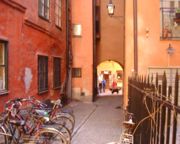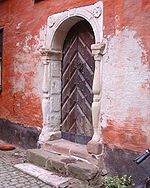
Staffan Sasses Gränd
Encyclopedia




Gamla stan
Gamla stan , until 1980 officially Staden mellan broarna , is the old town of Stockholm, Sweden. Gamla stan consists primarily of the island Stadsholmen. The surrounding islets Riddarholmen, Helgeandsholmen, and Strömsborg are officially part of, but not colloquially included in, Gamla stan...
, the old town in central Stockholm
Stockholm
Stockholm is the capital and the largest city of Sweden and constitutes the most populated urban area in Scandinavia. Stockholm is the most populous city in Sweden, with a population of 851,155 in the municipality , 1.37 million in the urban area , and around 2.1 million in the metropolitan area...
, Sweden
Sweden
Sweden , officially the Kingdom of Sweden , is a Nordic country on the Scandinavian Peninsula in Northern Europe. Sweden borders with Norway and Finland and is connected to Denmark by a bridge-tunnel across the Öresund....
. Stretching north from Köpmangatan
Köpmangatan
Köpmangatan is a street in Gamla stan, the old town of Stockholm, Sweden. A parallel street to Trädgårdsgatan, it is stretching from the central square Stortorget to Köpmantorget, intercepted by Trädgårdstvärgränd, Skeppar Olofs Gränd, Peder Fredags Gränd, Själagårdsgatan, Staffan Sasses Gränd,...
, it forms a parallel street to Bollhusgränd
Bollhusgränd
Bollhusgränd is an alley in Gamla stan, the old town in central Stockholm, Sweden. Named after Bollhuset, a historical theatre, it connects Slottsbacken to Köpmantorget, and as Baggensgatan extends the alley further south beyond Köpmangatan, together they form a parallel street to Österlånggatan...
and Peder Fredags Gränd
Peder Fredags Gränd
Peder Fredags Gränd is a small blind alley in Gamla stan, the old town in central Stockholm, Sweden. Stretching north from Köpmangatan, it is located between Skeppar Olofs Gränd and Staffan Sasses Gränd, just south of the Tessin Palace.The inconspicuous alley remained nameless until the 20th...
.
The alley is named after Staffan Sasse, a man originating from Westphalia
Westphalia
Westphalia is a region in Germany, centred on the cities of Arnsberg, Bielefeld, Dortmund, Minden and Münster.Westphalia is roughly the region between the rivers Rhine and Weser, located north and south of the Ruhr River. No exact definition of borders can be given, because the name "Westphalia"...
in Germany
Germany
Germany , officially the Federal Republic of Germany , is a federal parliamentary republic in Europe. The country consists of 16 states while the capital and largest city is Berlin. Germany covers an area of 357,021 km2 and has a largely temperate seasonal climate...
, who is mentioned as having bought a house belæget paa køpmana gatwne ("situated on Köpmangatan" (Merchant's Street)) in 1524, and the alley was associated with his name from 1569. He served, first under Sten Sture the Younger
Sten Sture the Younger
Sten Sture the Younger , Lord of Ekesiö , was a Swedish statesman and regent of Sweden, under the era of the Kalmar Union.-Life:...
(1493–1520), and then under King Gustav Vasa
Gustav I of Sweden
Gustav I of Sweden, born Gustav Eriksson of the Vasa noble family and later known simply as Gustav Vasa , was King of Sweden from 1523 until his death....
(1496–1560) during the ousting of the Danish forces. Staffan Sasse was raised to peerage
Peerage
The Peerage is a legal system of largely hereditary titles in the United Kingdom, which constitute the ranks of British nobility and is part of the British honours system...
in 1524 and appointed court bailiff
Bailiff
A bailiff is a governor or custodian ; a legal officer to whom some degree of authority, care or jurisdiction is committed...
in 1531.
The alley is mentioned as ' gamble ("old") Staffan Saxsses grändh ' in 1615, but is referred to as the alley of Blasius Dundie in 1609, the latter a merchant from Scotland
Scotland
Scotland is a country that is part of the United Kingdom. Occupying the northern third of the island of Great Britain, it shares a border with England to the south and is bounded by the North Sea to the east, the Atlantic Ocean to the north and west, and the North Channel and Irish Sea to the...
who is said to have owned a garden in the alley, at the time facing his building on the opposite side of Köpmangatan. His presence in Stockholm is first documented in 1576, and his business was apparently successful, since he owned a great number of properties in and around the city and is one of the renowned Blasius potentially having given his name to Blasieholmen, today a peninsula in central Stockholm but at the time an islet east of the city.
By the end of the 17th century, the alley was referred to as Jgnatij grendh after the printer Ignatius Meurer (1589–1672), a German who settled in Stockholm in 1610, arguably because his famous printing workshop was located in the alley. (See also Ignatiigränd
Ignatiigränd
Ignatiigränd is an alley in Gamla stan, the old town in central Stockholm, Sweden. Stretching from Västerlånggatan to Stora Nygatan, it forms a parallel street to Göran Hälsinges Gränd and Gåsgränd....
.)
In 1925, the alley was given back its old name.

